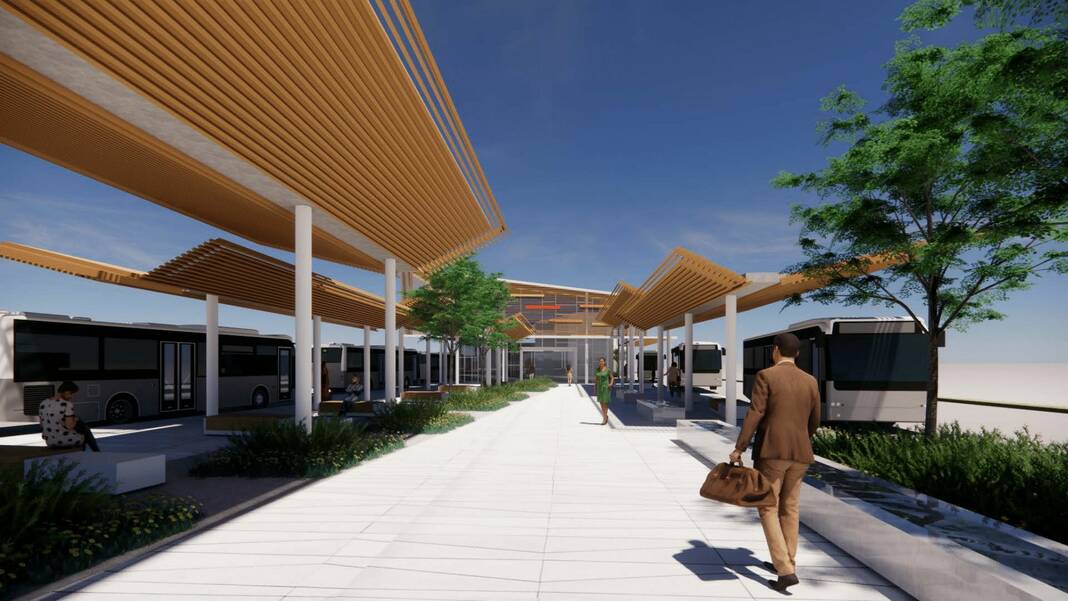
HARLINGEN — Hundreds of residents here have their hands in the design of the city’s $5.6 million transit center.
As part of the project to design the 10,000-square-foot building, officials posted an online survey on the city’s website, asking residents to pick between two canopy designs.
After two weeks, the results are in.
The transit center to stand at the city’s gateway will feature sloping “butterfly” canopies.
While 580 residents selected the butterfly design, 381 picked a more standard roof featuring a single slope.
“That was my personal preference,” Ana Hernandez, the city’s mobility and special projects director, said Tuesday, adding the butterfly canopies resemble those in City Hall’s parking lot that double as shelter for the Harlingen Farmer’s Market.
“I really like the canopies — they simulate the canopies we have in the parking lot,” she said. “It’s in different colors. There’s white and a material that looks like wood. It’s not just going to be pretty. It’s going to serve its purpose.”
City’s gateway
For more than six years, officials here have been working with the Lower Rio Grande Valley Development Council, planning to develop a transit center to serve as Valley Metro’s northern Cameron County transportation hub at 201 N. T St.
At the site of Valley Metro’s make-shift Harlingen terminal, the transit center will stand at the city’s gateway, Hernandez said.
“We conveyed that to the architect,” she said.
Canopy’s design
The transit center’s design features seven bus bays, passenger boarding and waiting areas, Valley Metro offices along with suites earmarked for restaurants and shops.
Last year, city commissioners hired Corpus Christi-based Gignac Architects for $340,000 to design the transit center funded through a $5.6 million grant from the Federal Transit Administration.
On Tuesday, Raymond Gignac, the firm’s founder, said he is designing the building’s canopies based on residents’ responses to the city’s survey.
“We just wanted something airy and aesthetically pleasing and not heavy, because the building isn’t a big building,” he said. “It’s kind of a throw-back to some of the canopies around City Hall. The sun’s going to move around during the day so (shade) is going to move. The most important thing is if you’re getting off a bus and it’s raining, you’re not going to get wet.”
Now, the architects are shopping around for the right materials for the job, Gignac said.
“It’s going to depend on the market and what we can afford,” he said, noting the project’s tight budget amid soaring materials’ costs. “Ideally, I’d like concrete but it might be extruded aluminum so it won’t rust.”
On June 28, City Commissioners Rene Perez and Frank Morales helped architect Juan Mujica, who works with Gignac, present the two designs to a group of residents at a meeting which launched the selection process.
The building’s overall design will “give a modern look to Harlingen,” Perez said.
Transit center development
The transit center’s development has been in the works for years.
In 2016, Harlingen’s updated 10-year master plan ranked the project as No. 13 on the city’s priority list.
During about five years of planning, officials picked the project site at 201 N. T St. based on its access to the highway system and the city’s main streets.
Three years later, city officials paid $291,000 to buy the 1.8-acre site on which the old Cameron County Precinct 4 warehouse formerly stood, fulfilling the federal grant’s requirement for local money to help fund the project.
While the city’s first public transit center will boast tall canopies looming over its open docking areas, including seven bus bays, its terminal will likely feature bus lines’ ticket counters, a fast-food restaurant, a shop and office space, officials said.
With its central regional location, the transit center will serve as Valley Metro’s northern Cameron County hub.
Inside its terminal, customers might buy tickets to board buses operated by Valley Metro and such companies as Valley Transit Co. and Greyhound.
Other companies such as Adame, Tornado and El Expreso might offer service into Mexico.
Background
Officials are counting on the center to help transform the area’s public transportation.
For decades, Valley Transit Co.’s station has served as the city’s bus center at 215 East Monroe Ave.
But the city has lacked a station to serve as a hub for bus lines bound for stops in the United States and Mexico.
So residents have boarded buses bound for those destinations outside a Stripes convenience store on Tyler Avenue near the Interstate 69 interchange.
Now, the transit center’s construction is set to begin in about six months, with completion planned for about the end of 2023, Mujica said.




